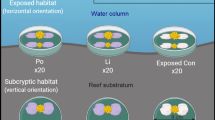Abstract
A new method for assessing coastal environments using the reproduction potential of corals has been developed and examined in situ. Six assessment racks were deployed before the full moon of May 2006 at three sites located around a river outlet in Nagura Bay, Ishigaki Is. and at one control location in Sekisei Lagoon. Each rack was equipped with two marine blocks (MB) containing 378 holes, two cases of coral settlement devices (CSDs), each containing 120 CSDs, and a water temperature logger. Assessment was based on recruitment of Acropora due to mass spawning. After 4 months of deployment, the surface of assessment racks showed apparent biofouling depending on sites mainly by algal settlement on the surfaces. Almost all the holes of the MBs were partly occupied, mainly by turf algae. Nagura Bay was thought likely to be an “unhealthy” coral reef due to runoff from land. However, our assessment showed that there were 0.85 corals per CSD in the Bay, compared with 0.51 in Sekisei Lagoon, indicating that coral larvae supply is not the cause of the unhealthy condition of corals in the Nagura Bay.








Similar content being viewed by others
References
Berkelmans R, Death G, Kininmonth S, Skirving WJ (2004) A comparison of the 1998 and 2002 coral bleaching events on the Great Barrier Reef: spatial correlation, patterns, and predictions. Coral Reefs 23:74–83
Nakano Y (2004) Global environmental change and coral bleaching. In: Ministry of the Environment, JCRS (ed) Coral reefs of Japan. Ministry of the Environment, Tokyo, pp 42–48
Okamoto M, Nojima S, Furushima Y (2007) Temperature environments during coral bleaching events in Sekisei Lagoon. Bull Jpn Soc Fish Oceanogr 71:112–121
Pet-Soede C, Cesar HSJ, Pet JS (1999) An economic analysis of blast fishing on Indonesian coral reefs. Environ Conserv 26:83–93
Mous PJ, Pet-Soede L, Erdman M, Cesar HSJ, Sadovy Y, Pet JS (2000) Cyanide fishing on Indonesian coral reefs for the live food fish market—what is the problem? SPC Live Reef Fish Info Bull 7:20–26
Fabricus KE (2005) Effects of terrestrial runoff on the ecology of corals and coral reefs: review and synthesis. Mar Pollut Bull 50:125–146
Ferrier-Pagis C, Gattuso JP, Dallot S, Jaubert J (2000) Effect of nutrient enrichment on growth and photosynthesis of the zooxanthellate coral Stylophora pistillata. Coral Reefs 19:103–113
Omija T (2003) Water pollution in coral reefs caused by soil runoff. Bull Coast Oceanogr 40:141–148 (in Japanese)
Komatsu T, Nakano M, Sugimoto T (2003) Changes in coastal ecosystem due to modifications of land use pattern. Bull Coast Oceanogr 40:145–157 (in Japanese)
Hughes TP (1994) Catastropes, phase shifts, and large-scale degradation of a Caribbean coral reef. Science 265:1547–1551
Okamoto M, Nojima S, Furushima Y, Phoel WC (2005) A basic experimental of coral culture using sexual reproduction in the open sea. Fish Sci 71:263–270
Shimoike K (2004) Sekisei Lagoon. In: JCRS and Ministry of the Environment (ed) Coral reefs of Japan. Ministry of the Environment, Tokyo, pp 219–224
Hasegawa H, Yamano H (2004) Ishigaki Island. In: JCRS and Ministry of the Environment (ed) Coral reefs of Japan. Ministry of the Environment, Tokyo, pp 212–218
Okamoto M, Nojima S, Fujiwara S, Furushima Y. Development of ceramic settlement devices for coral reef restoration using in situ sexual reproduction of corals. Fish Sci (in press)
Isoo T, Takahshi T, Fukhara M (2001) Using carbonated steelmaking slag blocks to help reduce CO2. Am Ceram Soc Bull 81:1
Yabuta K, Tozawa H, Takahashi T (2004) New application of iron and steelmaking slag, contributing to recycling-oriented society. JFE Bull 6:24–29 (in Japanese)
ISRS (2004) The effects of terrestrial runoff of sediments, nutrients and other pollutants on coral reefs. Briefing paper 3, Int Soc Reef Stud, pp 18
McCook LJ, Jompa J, Diaz-Pulido G (2001) Competition between corals and algae on coral reefs: a review of evidence and mechanisms. Coral Reefs 19:400–417
Kawahata H, Yukino I, Suzuki A (2000) Terrestrial influences on the Shiraho fringing reef, Ishigaki Island, Japan: high carbon input relative to phosphate. Coral Reefs 19:172–178
Acknowledgments
The authors would like to thank Professor Syunsuke Ikeda of Tokyo Institute of Technology, Professor Jun Matsushita of Shibaura University and Associate Professor Kazutoshi Osawa of Utsunomiya University, and Associate Professor Satoshi Nojima of Kyushu University for their collaboration in this study. We are grateful to Mr. Itaru Oguro, retired Diving Superintendent of JAMSTEC, and Mr. Yuichiro Tamura, master course student of Tokyo University of Marine Science and Technology, for their assistance in the experiment. This study was funded by a Grant-in-Aid for Scientific Research (nos. 17106006 and 16201027).
Author information
Authors and Affiliations
Corresponding author
Rights and permissions
About this article
Cite this article
Roeroe, K.A., Yap, M. & Okamoto, M. Development of a coastal environment assessment system using coral recruitment. Fish Sci 75, 215–224 (2009). https://doi.org/10.1007/s12562-008-0031-7
Received:
Accepted:
Published:
Issue Date:
DOI: https://doi.org/10.1007/s12562-008-0031-7




